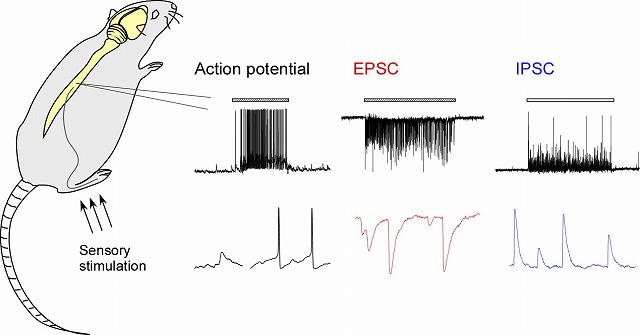- In vivo nocieptive synaptic transmission and its plastic change
The spinal dorsal horn, especially superficial dorsal horn, has an important role in the transmission and modulation of nociceptive information. Superficial dorsal horn neurons make excitatory synaptic contacts with noxious primary afferent fibers. In addition, dorsal horn neurons receive inhibitory synaptic inputs from spinal interneurons and descending inhibitory neurons in the brain stem. We investigate the spinal modulatory mechanism of nociceptive transmission by using in vivo patch-clamp recording techniques (Figure). We also study the underlying mechanism for the development of chronic pain. Behavioral and immunohistochemical analyses are also used.

Figure. In vivo patch-clamp recording from spinal dorsal horn neuron.
1. Furue H*, Katano T*, Okuda-Ashitaka E, Tagaya M, Watanabe M, Yoshimura
M and Ito S (*contributed equally). N-Ethylmaleimide-sensitive fusion protein
(NSF) is involved in central sensitization in the spinal sord through GluR2
subunit composition switch after inflammation. European Journal of Neuroscience
27(12):3161-3170, 2008
2. Furue H* , Suzuki SC*, Koga K, Jiang N, Nohmi, M, Shimazaki Y, Katoh-Fukui
Y, Yokoyama M, Yoshimura M, Takeichi M (*contributed equally). Cadherin-8
is Required for the First Relay Synapses to Receive Functional Inputs from
Primary Sensory Afferents for Cold Sensation. Journal of Neuroscience 24:3466-3476,
2007
3. Furue H, Katafuchi T, Yoshimura M. In vivo patch. In:Patch-Clamp Analysis:
Advanced Technique, Second Edition (Eds. Wolfgang Walz) The Humana Press
Inc pp.229-251, 2007
4. Furue H, Narikawa K, Kumamoto E and Yoshimura M. Responsiveness of rat
substantia gelatinosa neurons to mechanical but not thermal stimuli revealed
by in vivo patch-clamp recording. Journal of Physiology(London) 521:529-535,
1999


